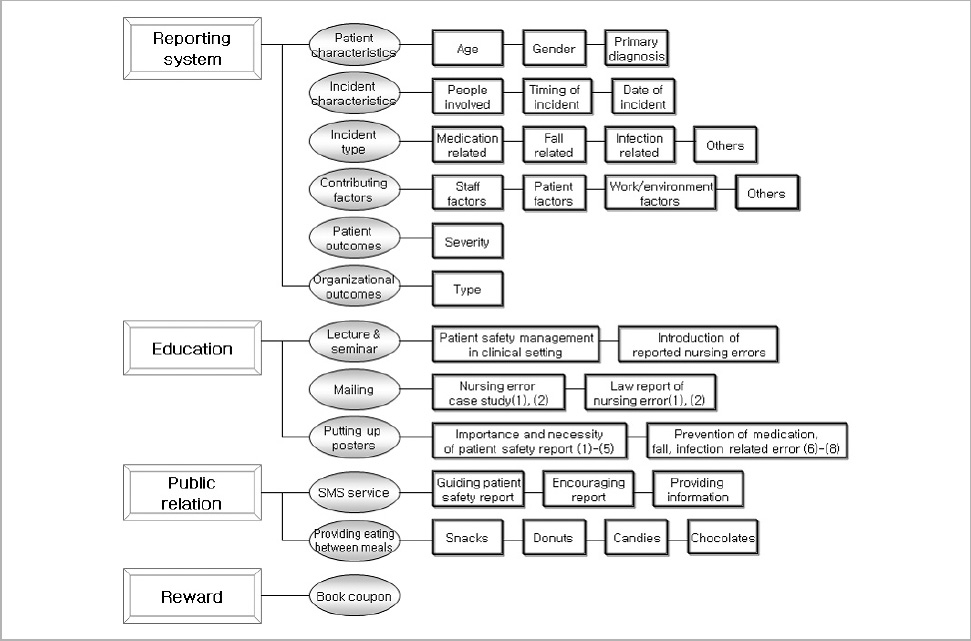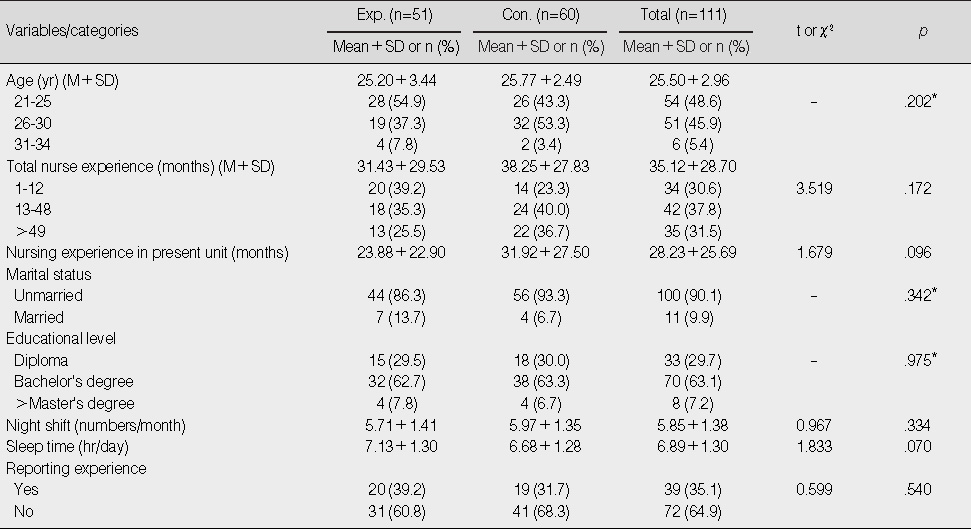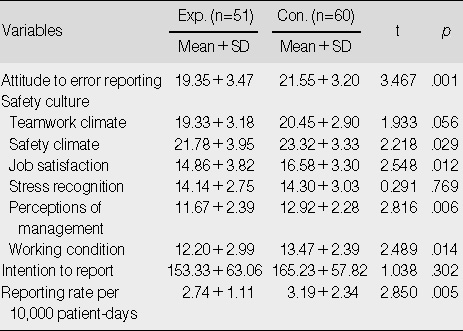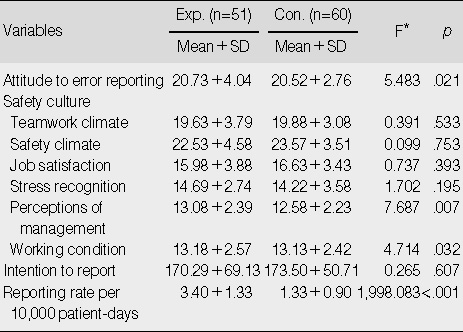Articles
- Page Path
- HOME > J Korean Acad Nurs > Volume 40(2); 2010 > Article
-
Original Article
- The Effectiveness of Error Reporting Promoting Strategy on Nurse's Attitude, Patient Safety Culture, Intention to Report and Reporting Rate
- Myoungsoo Kim
-
Journal of Korean Academy of Nursing 2010;40(2):172-181.
DOI: https://doi.org/10.4040/jkan.2010.40.2.172
Published online: April 30, 2010
Full-time Lecturer, Department of Nursing, Pukyong National University, Busan, Korea.
- Address reprint requests to: Kim, Myoungsoo. Department of Nursing, Pukyong National University, 599-1 Daeyeon 3-dong, Nam-gu, Busan 608-737, Korea. Tel: 82-51-629-5782, Fax: 82-51-629-5789, kanosa@hanmail.net
Copyright © 2010 Korean Society of Nursing Science
Abstract
-
Purpose
- The purpose of this study was to examine the impact of strategies to promote reporting of errors on nurses' attitude to reporting errors, organizational culture related to patient safety, intention to report and reporting rate in hospital nurses.
-
Methods
- A nonequivalent control group non-synchronized design was used for this study. The program was developed and then administered to the experimental group for 12 weeks. Data were analyzed using descriptive analysis, χ2-test, t-test, and ANCOVA with the SPSS 12.0 program.
-
Results
- After the intervention, the experimental group showed significantly higher scores for nurses' attitude to reporting errors (experimental: 20.73 vs control: 20.52, F=5.483, p=.021) and reporting rate (experimental: 3.40 vs control: 1.33, F=1998.083, p<.001). There was no significant difference in some categories for organizational culture and intention to report.
-
Conclusion
- The study findings indicate that strategies that promote reporting of errors play an important role in producing positive attitudes to reporting errors and improving behavior of reporting. Further advanced strategies for reporting errors that can lead to improved patient safety should be developed and applied in a broad range of hospitals.
This work was supported by National Research Foundation of Korea Grant funded by the Korean Government (KRF-2008-331-E00428).
- 1. Dovey SM, Phillips RL. What should we report to medical error reporting systems? Quality & Safety in Health Care. 2004;13:322–323.Article
- 2. Elder NC, Graham D, Brandt E, Hickner J. Barriers and motivators for making error reports from family medicine offices: A report from the American Academy of Family Physicians National Research Network (AAFP NRN). Journal of the American Board of Family Medicine. 2007;20:115–123.ArticlePubMed
- 3. Etchell E, O'Neill C, Bernstein M. Patient safety in surgery: Error detection and prevention. World Journal of Surgery. 2003;27:936–942.ArticlePubMedPDF
- 4. Feng X, Bobay K, Weiss M. Patient safety culture in nursing: A dimensional concept analysis. Journal of Advanced Nursing. 2008;63:310–319.ArticlePubMed
- 5. Firth-Cozens JR, Firth A, Booth S. Attitudes to and experiences of reporting poor care. Clinical Governance. 2004;8:331–336.Article
- . Force MV, Deering L, Hubbe J, Andersen M, Hagemann B, Cooper-Hahn M, et al. Effective strategies to increase reporting of medication errors in hospitals. Journal of Nursing Administration. 2006;36:34–41.ArticlePubMed
- 7. Gladstone J. Drug administration errors: A study into the factors underlying the occurrence and reporting of drug errors in a district general hospital. Journal of Advanced Nursing. 1995;22:628–637.ArticlePubMed
- 8. Grant MJ, Larsen GY. Effect of an anonymous reporting system on near-miss and harmful medical error reporting in a pediatric intensive care unit. Journal of Nursing Care Quality. 2007;22:213–221.ArticlePubMed
- 9. Handler SM, Altman RL, Perera S, Hanlon JT, Studenski SA, Bost JE, et al. A systematic review of the performance characteristics of clinical event monitor signals used to detect adverse drug events in the hospital setting. Journal of the American Medical Informatics Association. 2007;4:451–458.
- 10. Hughes CM, Lapane KL. Nurses' and nursing assistants' perceptions of patient safety culture in nursing homes. International Journal for Quality in Health Care. 2006;18:281–286.ArticlePubMed
- 11. Kagan I, Barnoy S. Factors associated with reporting of medication errors by Israeli nurses. Journal of Nursing Care Quality. 2008;23:353–361.ArticlePubMed
- 12. Kaissi A. An organizational approach to understanding patient safety and medical errors. Health Care Management. 2006;25:292–305.Article
- 13. Kim J, An K, Kim MK, Yoon SH. Nurses' perception of error reporting and patient safety culture in Korea. Western Journal of Nursing Research. 2007;29:827–844.ArticlePubMedPDF
- 14. Kim J, Bates DW. Results of a survey on medical error reporting systems in Korean hospitals. International Journal of Medical Informatics. 2006;75:148–155.ArticlePubMed
- 15. Kim MS, Kim JS, Jung IS, Kim YH, Kim HJ. The effectiveness of the error reporting promoting program on the nursing error incidence rate in Korean operating rooms. Journal of Korean Academy of Nursing. 2007;37:185–191.ArticlePubMedPDF
- 16. Kohn LT, Corriagan JM, Donaldson MS. To err is human. Building a safer health system. 2000;Washingson DC, National Academy Press.Article
- 17. Leape LL. Error in medicine. JAMA. 1994;272:1851–1857.ArticlePubMed
- 18. Mekhjian HS, Bentley TD, Ahmand A, Marsh G. Development of a web based event reporting system in an academic environment. Journal of the American Medical Informatics Association. 2004;11:11–18.ArticlePubMedPMC
- 19. Milch CE, Salem DN, Pauker SG, Lundquist TG, Kumar S, Chen J. Voluntary electronic reporting of medical errors and adverse events. An analysis of 92,547 reports from 26 acute care hospitals. Journal of General Internal Medicine. 2006;21:165–170.ArticlePubMedPMC
- 20. Osborne J, Blais K, Hayes JS. Nurses' perceptions: When is it a medication error? Journal of Nursing Administration. 1999;29(4):33–38.
- 21. Paradis AR, Stewart VT, Bayley KB, Brown A, Bennett AJ. Excess cost and length of stay associated with voluntary patient safety event reports in hospitals. American Journal of Medical Quality. 2009;24:53–60.ArticlePubMedPDF
- 22. Park S, Kwon IG. Factors influencing nurses' clinical decision making -Focusing on critical thinking disposition-. Journal of Korean Academy of Nursing. 2007;37:863–871.ArticlePubMedPDF
- . Robinson AR, Hohmann KB, Rifkin JI, Topp D, Gilroy CM, Pickard JA, et al. Physician and public opinions on quality of health care and the problem of medical errors. Archives of Internal Medicine. 2002;162:2186–2190.ArticlePubMed
- 24. Sexton JB, Thomas EJ, Helmreich RL. Error, stress and teamwork in medicine and aviation; Cross-sectional surveys. BMJ. 2000;320(7237):745–749.ArticlePubMedPMC
- 25. Sorra J, Nieva V, Fastman BR, Kaplan H, Schreiber G, King M. Staff attitudes about event reporting and patient safety culture in hospital transfusion services. Transfusion. 2008;48:1934–1942.ArticlePubMed
- 26. Suresh G, Horbar JD, Plsek P, Gray J, Edwards WH, Shrono PH, et al. Voluntary anonymous reporting of medical errors for neonatal intensive care. Pediatrics. 2004;113:1609–1618.ArticlePubMedPDF
- 27. Thompson C, Dowding D. Awareness and prevention of error in clinical decision-making. Nursing Times. 2004;100(23):40–43.
- 28. Throckmorton T, Etchegaray J. Factors affecting incident reporting by registered nurses: The relationship of perceptions of the environment for reporting errors, knowledge of the nursing practice act, and demographics on intent to report errors. Journal of Perianesthesia Nursing. 2007;22:400–412.ArticlePubMed
- 29. Undre S, Sevdalis N, Healey AN, Darzi A, Vincent CA. Observational teamwork assessment for surgery (OTAS): Refinement and application in urological surgery. World Journal of Surgery. 2007;31:1373–1381.ArticlePubMedPDF
- 30. Weingart SN, Callanan LD, Aronson MD. A physician-based voluntary reporting system for adverse event and medical errors. Journal of General Internal Medicine. 2001;16:809–814.PubMedPMC
REFERENCES
Figure & Data
REFERENCES
Citations

- The mediating role of moral courage in the relationship between ethical leadership and error reporting behavior among nurses in Saudi Arabia: a structural equation modeling approach
Ebtisam A. Elhihi, Khadija Lafi Aljarary, Maha Alahmadi, Jawaher Bakor Adam, Ohud Atiah Almwualllad, Marwan S. Hawsawei, Abdulmajid Ahmad Hamza, Ibrahim Abdullatif Ibrahim
BMC Nursing.2025;[Epub] CrossRef - Impact of Nursing Professionalism, Ethical Sensitivity, and the Clinical Learning Environment on Nursing Students' Intention to Report Near Misses and Adverse Events
Sookhee Yoon, Ha-Young Park
Journal of Korean Academy of Fundamentals of Nursing.2025; 32(2): 209. CrossRef - Safety voice concept clean-up: Examining the voice that challenges us to be safer
Jeanne Paul, Colin Pilbeam, Anna Smallwood
Safety Science.2025; 191: 106931. CrossRef - Fostering a safe horizon: Nursing organizational culture as a mediator between medication safety climate and reporting intentions for high-alert medication errors among pediatric nursing care
Abdelaziz Hendy, Rasha Kadri Ibrahim, Hosny Maher Sultan, Hanan F. Alharbi, Zeinab Al-Kurdi, Naglaa Hassan Abuelzahab, Taliaa Mohsen Al-Yafeai, Ahmad Ahmeda, Zainab Attia Abdallah, Wesam Taher Almagharbeh, Ghada Ahmed Hassan
Journal of Pediatric Nursing.2025; 85: 103. CrossRef - Attitudes towards patient safety among physicians and nurses in Iranian governmental teaching hospitals: a cross-sectional survey
Edris Kakemam, Farzaneh Miri, Sevda Sadeghpour, Alireza Mirzaei, Jalal Saeidpour
BMJ Open.2024; 14(11): e089328. CrossRef - Exploring research trends in nursing organizational culture using topic modeling
Eun-Jun Park, Chan Sook Park
The Journal of Korean Academic Society of Nursing Education.2024; 30(4): 371. CrossRef - Testing the association between the enabling and enacting factors of patient safety culture and patient safety: structural equation modelling
Seung Eun Lee, V. Susan Dahinten, Jong Hyun Lee
BMC Nursing.2023;[Epub] CrossRef - Association of Job Crafting and Perception of Patient Safety Culture with Patient Safety Management Activities among Hospital Nurses
Jung Sook Kim, Ji-Soo Kim
Journal of Korean Academy of Nursing Administration.2022; 28(4): 382. CrossRef - Factors Affecting Willingness to Medical Error-reporting of Nursing Students
Eunsim Kim, Juyoun Yu
Journal of Korean Academy of Nursing Administration.2022; 28(4): 440. CrossRef - Psychological Safety as a Mediator of the Relationship Between Inclusive Leadership and Nurse Voice Behaviors and Error Reporting
Seung Eun Lee, V. Susan Dahinten
Journal of Nursing Scholarship.2021; 53(6): 737. CrossRef - The influence of nurse leadership style on the culture of patient safety incident reporting: a systematic review
Yusriawati Yusuf, Andi Masyitha Irwan
British Journal of Healthcare Management.2021; 27(6): 1. CrossRef - A Phenomenological Study on Nurses' Experience of Near Miss in Medication Administration
Jin Hee Park, Kyoung Ran Kong
Journal of Korean Academy of Nursing Administration.2021; 27(3): 127. CrossRef - Factors Influencing Clinical Nurses’ Intention to Report Medication Administration Errors
Seul Hee Lee, Eun Ji Seo
Journal of Korean Critical Care Nursing.2021; 14(3): 62. CrossRef - The impact of patient safety culture and the leader coaching behaviour of nurses on the intention to report errors: a cross-sectional survey
Zahra Chegini, Edris Kakemam, Mohammad Asghari Jafarabadi, Ali Janati
BMC Nursing.2020;[Epub] CrossRef - Patient safety culture among nurses working in Palestinian governmental hospital: a pathway to a new policy
Nasser Ibrahim Abu-El-Noor, Mysoon Khalil Abu-El-Noor, Yousef Zuheir Abuowda, Maha Alfaqawi, Bettina Böttcher
BMC Health Services Research.2019;[Epub] CrossRef - Barriers to reporting of patient safety incidents in tertiary hospitals: A qualitative study of nurses and resident physicians in South Korea
Won Lee, So Yoon Kim, Sang‐il Lee, Sun Gyo Lee, Hyung Chul Kim, Insook Kim
The International Journal of Health Planning and Management.2018; 33(4): 1178. CrossRef - Factors Affecting Nursing Students’ Perception on Pediatric Patient Safety Culture and Nursing Activity
Eunsook Park, Won-Oak Oh, Mirim Kim
Child Health Nursing Research.2017; 23(4): 534. CrossRef - The Relationships Among Perceived Patients' Safety Culture, Intention to Report Errors, and Leader Coaching Behavior of Nurses in Korea: A Pilot Study
YuKyung Ko, Soyoung Yu
Journal of Patient Safety.2017; 13(3): 175. CrossRef - Discriminating Power of Organization Related Variables on Intention to Medication Error Reporting
Myoung Soo Kim
Journal of Health Informatics and Statistics.2016; 41(2): 155. CrossRef - A Comparative Study on Perception of Patient Safety Culture and Safety Care Activities: Comparing University Hospital Nurses and Small Hospital Nurses
Bo Kyoung Cha, Jung Choi
Journal of Korean Academy of Nursing Administration.2015; 21(4): 405. CrossRef - The Mediating and Moderating Roles of Safety-specific Transformational Leadership on the Relationship between Barrier to and Intention of Reporting Medication Errors
Myoung Soo Kim
Korean Journal of Adult Nursing.2015; 27(6): 673. CrossRef - Assessing Safety Attitudes among Healthcare Providers after a Hospital-Wide High-Risk Patient Care Program
Sang Mo Je, Hyun Jong Kim, Je Sung You, Sung Phil Chung, Junho Cho, Jin Hee Lee, Hahn Shick Lee, Hyun Soo Chung
Yonsei Medical Journal.2014; 55(2): 523. CrossRef - Canonical correlation between organizational characteristics and barrier to medication error reporting of nurses
Min-Jeong Kim, Myoung Soo Kim
Journal of the Korea Academia-Industrial cooperation Society.2014; 15(2): 979. CrossRef - Development and Validation of the Korean Patient Safety Culture Scale for Nursing Homes
Sook Hee Yoon, Byungsoo Kim, Se Young Kim
Journal of Korean Academy of Nursing.2013; 43(3): 379. CrossRef - Role of Transformational-leadership in the Relationship between Medication Error Management Climate and Error Reporting Intention of Nurse
Myoung Soo Kim
Korean Journal of Adult Nursing.2013; 25(6): 633. CrossRef - Development and Evaluation of Patient Safety Reporting Promoting Education Program
Myoung-Soo Kim, Yun-Hee Kim
Journal of the Korea Academia-Industrial cooperation Society.2012; 13(1): 284. CrossRef

Figure 1
Homogeneity Test for General Characteristics between Experimental and Control Group
* Fisher exact test.
Con.=control group; Exp.=experimental group.
Homogeneity Test of Study Variables at the Baseline
Con.=control group; Exp.=experimental group.
Group Comparisons of Dependent Variables at the posttest
* F-value of ANCOVA with pre-test value as covariate.
Con.=control group; Exp.=experimental group.
* Fisher exact test. Con.=control group; Exp.=experimental group.
Con.=control group; Exp.=experimental group.
* F-value of ANCOVA with pre-test value as covariate. Con.=control group; Exp.=experimental group.
 KSNS
KSNS
 E-SUBMISSION
E-SUBMISSION




 Cite
Cite

